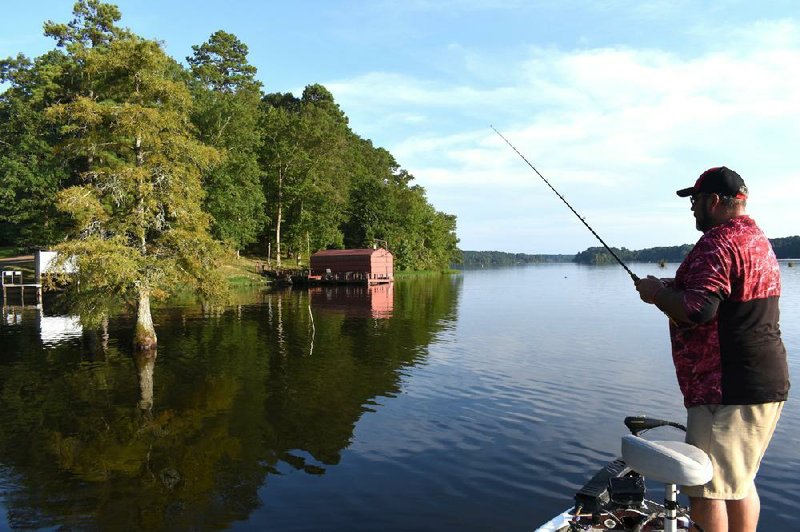Having learned to use the major fishing lures, you now need a place to fish.
Fortunately, Arkansas has every variety of freshwater fishing on the menu. We have big Corps of Engineers reservoirs and small flood control lakes. We have municipal water supply reservoirs, Arkansas state parks lakes, irrigation reservoirs and farm ponds. We have big rivers, medium-size rivers and small rivers. We have big creeks and little creeks. And, of course, we have Arkansas Game and Fish Commission lakes created and managed especially for public fishing.
For beginning anglers, the Corps of Engineers lakes are too big of a bite. Inexperienced eyes will be intimidated and discouraged by vast expanses of featureless water. These are better suited for advanced anglers, so we recommend them when you become proficient on smaller waters. To develop the requisite skills, few places are better for novice anglers than Game and Fish Commission lakes.
Lake Conway is our favorite. It is easy to reach from anywhere in Central Arkansas, and acre for acre it is one of the best lakes in the state to catch largemouth bass, crappie, bream and catfish. The Game and Fish Commission stocks Lake Conway with Florida strain largemouths, so it has a reputation for bigger than average fish. It has bluegills in shallow water and redears (shellcrackers) in deep water. It also supports an excellent population of white crappie.
One nice feature about Game and Fish lakes is that they are lightly fished and lightly visited. You never have to contend with water skiers, tubers and pleasure boaters.
Lake Conway is full of eye candy in the form of standing timber, lily pads, fallen trees and logs along the shore, boat docks and brush piles. Fish orient to all of these features, and you don't need electronic graphs or any other devices to fish them.
Similar Game and Fish Commission destinations include lakes Pickthorne (Jacksonville), Overcup (Morrilton), Kingfisher (Morrilton), Bob Kidd (Prairie Grove), Barnett (Heber Springs) and Jack Nolen (Greenwood).
There are two ways to go about fishing Game and Fish lakes. You can concentrate on becoming an expert on just one, or you can visit multiple sites for changes of pace and flavor. Both strategies will build your skill set, but fishing multiple lakes will make you more versatile.
For the same reasons, flood control lakes and municipal water supply reservoirs are great places to fish. Flood control lakes are in remote areas, usually in the mountainous regions. One of my favorites is Lake Hinkle near Waldron, an excellent but underrated hot spot for bass and crappie fishing.
A cluster of excellent flood control lakes are accessible from Arkansas 7 near Jessieville and Hollis, including Cedar Creek, Dry Fork, Cove Creek and Little Bear Lakes. Cedar Piney Lake near Belleville is also very good. There are several unnamed lakes near Waldron. They are considerably smaller than Game and Fish lakes, but they are lightly fished and offer excellent fishing.
Municipal water supply reservoirs are some of my favorite places to fish. The most popular, of course, is Lake Maumelle, whose size more closely resembles a Corps of Engineers lake. Lake Winona, near Perryville, is a more manageable size and offers, at times, excellent fishing for bass, bream and, I'm told, walleye.
Mitch Looper of Hackett, a noted big bass specialist, introduced me to the excellence of water supply lakes more than 20 years ago during a series of articles we did together at the Ozark and Waldron city reservoirs, and also at Lake Shepherd Springs, which is now part of the greater Lake Fort Smith. Our success at those lakes will be part of a Master Fishing Series that will follow the beginner series, but here's a teaser. We caught multiple 7- and 8-pounders at Waldron, and Looper caught a pure northern strain largemouth that weighed 14 pounds, 14 ounces at Ozark City Reservoir, a little postage stamp piece of water that you can see for an instant within the folds of the hills a few miles north of Interstate 40 when approaching the Arkansas 23 exit.
Similar stories abound at the Paris and Prairie Grove city lakes, and I've had some wonderful days fishing at Pottsville city lake and Huckleberry Lake, which serves the city of Russellville.
These waters lack significant cover except along the shorelines, making them great places to refine your shallow fishing techniques. Again, we will cover these in the Master Fishing series.
Finally, Arkansas has an abundance of moving waters. The Arkansas River is our largest and most prominent interior river, and while it appears forbidding, it is easy to fish if you break it into bite-size chunks. Pick a tributary or a section of side waters and learn them as if they were ponds.
Smaller rivers, like the lower Ouachita River and the lower White River, offer the same features in a more user-friendly format.
Small rivers are my favorites. They are simple to fish and harbor excellent populations of smallmouth and Kentucky bass, and smaller numbers of largemouth bass. You can fish long stretches of them in canoes or kayaks, or you can wade fish. Some of my favorites are the Buffalo, Caddo, Strawberry, Saline, Kings, Spring and Fourche Rivers. Small White River tributaries upstream and downstream of Mountain View offer excellent fishing, especially when hydropower generation swells the White River.
The joy in fishing all of these places is merely being there. Fishing allows you to interact with them on the most intimate, most visceral levels and success will foster an appreciation that you can get no other way.
Tenth installment of the Beginner’s Fishing Series.
Sports on 06/04/2020
